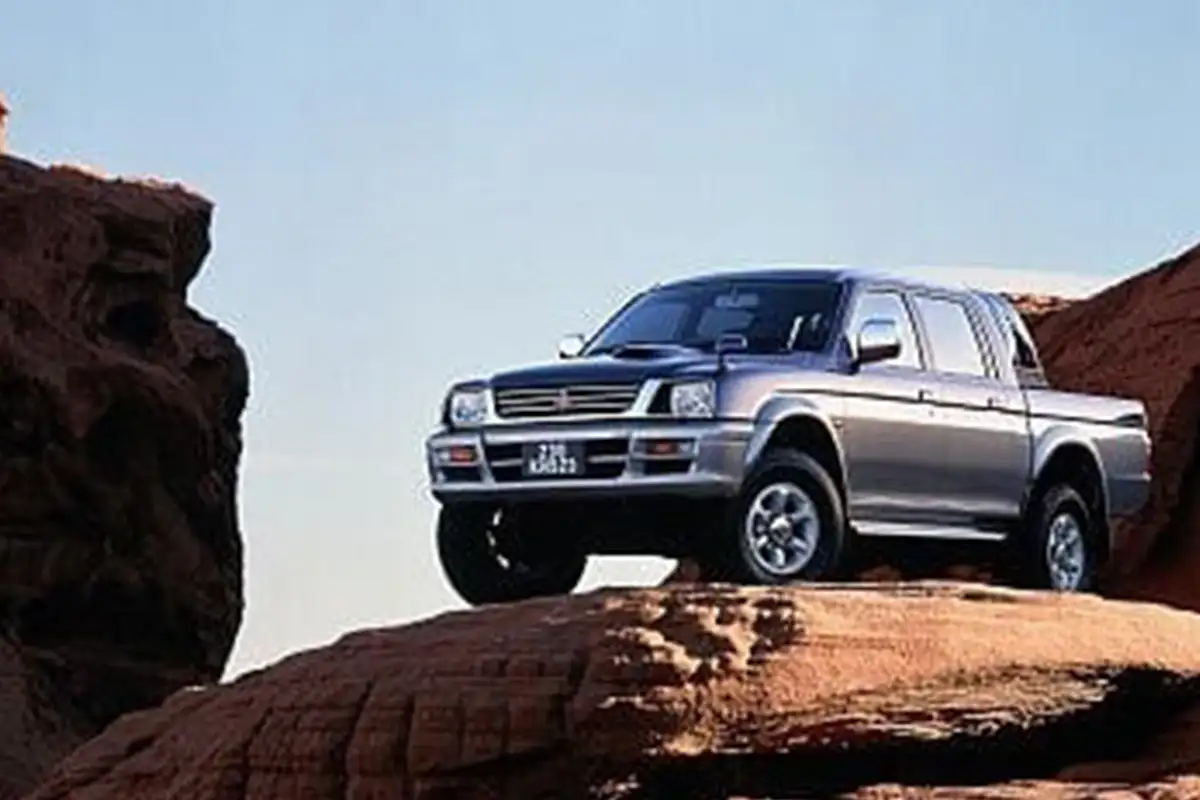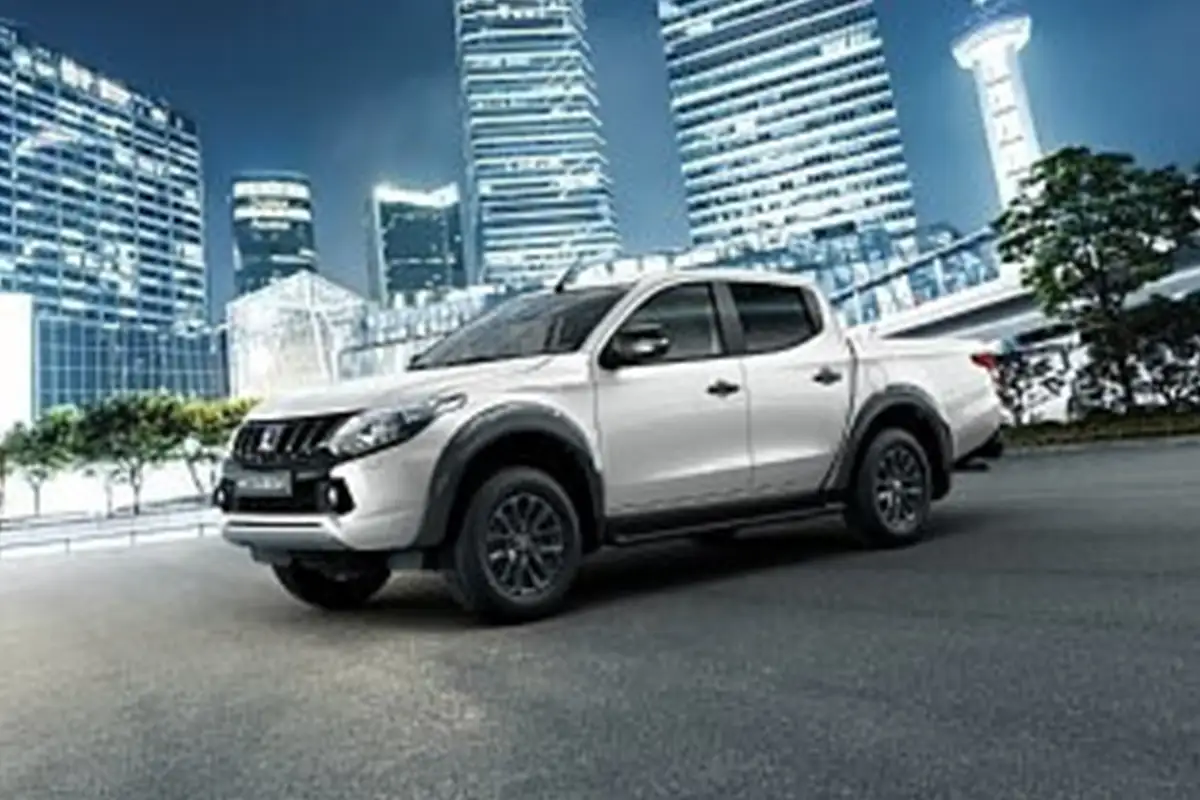
Mitsubishi Triton 1978

Mitsubishi Triton 2006
Kindly find adaptation of press release below from Mitsubishi Motors Corporation:
It's 1978, and the world is changing. Space Invaders spreads to arcades across the globe and launches the video game industry. The first automated cellular phone network is being built in Japan and Superman takes off in cinemas. Another product is launched which, over the next four decades, will bring mobility to 4.7 million people - the Mitsubishi 1-ton pickup. It's a pickup truck that can handle all types of road, anywhere on the planet. It has been developed with a design brief - to meet the desire of customers for a pickup with outstanding reliability, durability and payload performance; with levels of drivability, utility, comfort and ride that are on a par with a passenger sedan.
The first models were appropriately named FORTE, although exports used other badges such as L200, which remain in use today. From the very beginning, the FORTE was engineered to provide tough, dependable transport for people and goods.
The FORTE was developed to provide a 1-ton carrying capacity and yet be as easy to drive, have a combination of rugged reliability, easy-to-drive nature and impressive carrying capacity. This soon made it a firm favorite across the world, from frozen wastes to sun-baked deserts.
To ensure customers could go even further afield, Mitsubishi Motors built on its four-wheel-drive heritage by adding a 4x4 version to the range in 1980. This became the foundation for modern Mitsubishi 4WD vehicles, leading directly to the PAJERO/MONTERO and DELICA.
The pickup, soon renamed TRITON in many markets, had a profound effect on the Mitsubishi Motors' business too. The first and second generation platforms were mainly produced at Mitsubishi Motors Ohe Plant. Since the third-generation model in 1995, production has been concentrated in the Laem Chabang Plant in Thailand, from where they are exported worldwide. It is now Mitsubishi Motors' biggest factory, producing about 400,000 vehicles.
Here is a reminder of the previous generations of the FORTE, TRITON and L200 - and a glimpse at what the near future might hold.
September 1978
October 1980






1st Generation 1978 FORTE/L200
There is a huge overseas demand, particularly in North America, for small pickup trucks, where they are used casually for commuting to school and work, as well as for recreation.
Mitsubishi Motors introduced its first 1-ton pickup truck with the name FORTE in September 1978, and began to export to North America from the following October.
The name for the 1-ton pickup truck "FORTE" means "strong" in Italian. The prototypes underwent rigorous endurance testing on a massive scale in North America, Thailand, and Saudi Arabia to ensure reliability. A total of approximately 657,000 vehicles were produced in the Ohe Plant in Japan, and partially in the Laem Chabang Plant in Thailand.
The styling took its cues from the compact sedan GALANT, with a long nose, an air-dam skirt which was introduced for trucks for the first time, and four round headlights. The FORTE was powered by a 2.0-litre and 2.6-litre petrol engines for North America and 1.6-litre petrol engine for Japan and other regions. A 2.3-litre diesel engine was available for general exports. Its wide 1,360mm front track and long wheelbase of 2,780mm ensured superior driving stability.
The chassis was sophisticated for a commercial vehicle too, with front disc brakes, double wishbone/coil springs for the front suspension, and leaf springs and rigid axle in the rear.
The very quiet interior results from an uncompromising approach to NVH performance, which includes the use of a 2-piece prop shaft and the generous use of strategically-placed sealing materials.
Mitsubishi Motors leveraged its many years of experience of building Jeeps, and added a newly-developed part-time 4WD transfer system with a directly-linked silent chain. This system reduced gear noise and power loss, and enabled high-speed on-road driving.
This model served as the forerunner for Mitsubishi Motors' 4WD lineup such as the PAJERO/MONTERO and the DELICA.
2nd Generation 1986 STRADA/L200
There was a full model change in March 1986.
The exterior sports a classy makeover with a new front grille design, among other detail changes. And the lines create a shape that looks as tough and modern as it is aero-efficient.
A wider variety of configurations were offered, including three body types: Single Cab, Club Cab, Double Cab, short and long body style available for Single Cab, 2WD and 4WD drivetrain options, 2.0-litre and 2.6-litre gasoline engines, and 2.5-litre diesel engine.
The naming changed too, with double-cab STRADA being introduced in Japan in 1991. The model was also called MIGHTY MAX in North America, TRITON in Australia, and L200 in other areas. In North America, it was also sold by Dodge as the RAM 50.
A total of approximately 1,146,000 2nd generation models were produced in the Ohe Plant in Japan, and the Laem Chabang Plant in Thailand.
3rd Generation 1995 STRADA/L200
Production of the third generation STRADA/L200 began in November 1995 in Thailand. The interior and exterior designs were fully revised to give a distinctive and cutting-edge look.
The new style reflected the customer need to have a pickup truck which could also be used as a passenger car for personal use. The model was positioned as a roomy five seater that was comfortable and capable enough for both recreational and commercial uses.
Power and off-road performance were improved with a 2.5-litre intercooled turbodiesel engine and features such as "Easy Select 4WD." Safety and equipment levels were also enhanced to match the expectations of buyers used to passenger car levels of comfort.
The STRADA/L200 was sold in Thailand and also exported to Europe, Oceania, Latin America, the Middle East and Africa. A total of approximately 1,046,000 vehicles were produced.
It featured:
4th Generation 2005 TRITON/L200
In August 2005 there is full model change and after its introduction in Thailand in 2005 it was exported in stages to approximately 150 countries worldwide, becoming an important model in Mitsubishi Motors' global strategy.
The TRITON/L200 was developed with the following three key features to help it conquer the world. First, it had to exceed the basic performance requirements of pickup trucks such as economy, durability, and reliability. Second, it had to have the highest quality standards to further strengthen the brand on a global scale. And lastly, it had to meet a wide variety of customer needs, not just be a commercial use vehicle.
A total of 1,423,000 4th generation TRITON/L200 were produced.
Characteristic features of the 2005 TRITON/L200 include an innovative interior and exterior design which suggests sportiness while also being stylish. The packaging gives the roomiest interior in its class, while the suspension and interior equipment enable ride comfort to rival passenger cars.
These elements not only highlighted the innovativeness of the TRITON/L200 in the marketplace, but dispelled the general image of pickup trucks as merely commercial vehicles. This greatly expanded the customer base of Mitsubishi Motors' pickup trucks.
A newly developed diesel engine with a direct injection common rail produced high power while achieving low fuel consumption, exhaust emissions, and noise levels.
The newly designed body also achieved the highest level of crashworthiness in its class. Participation in the Dakar Rally and other races built up its superior off-road 4WD performance and helped tell the world about the TRITON/L200's toughness.
5th Generation 2014 TRITON/L200
In 2014, the new 5th generation TRITON/L200 further refines the concept to meet with the increasingly varying needs of customers. Improved usability and durability for commercial use, a sporty feel that is both easy and fun to drive, quality that gives customer satisfaction, and comfort for every passenger are all qualities that the new TRITON/L200 has realized, evolving into the "ultimate sports utility truck."
Three cabin types are offered to meet each purpose: Single Cab, Double Cab, and double door Club Cab.
The 2.5-litre turbodiesel and 2.4-litre gasoline engines have been improved and are offered alongside a newly-developed 2.4-litre MIVEC "clean" turbodiesel. It delivers superior performance while achieving top-level fuel economy and lower CO2 emissions. A 6-speed manual and 5-speed automatic transmission with sports mode are also offered for the first time.
The 4WD systems continue to develop too. The "Easy Select 4WD" system has three positions: 2H, 4H, 4L to provide optimum traction to match road conditions, and the "Super Select 4WD-II," with an electronic actuator.
A 2WD option is still offered, including the standard version and a "High Rider" model which has the same ground clearance as the 4WD for improved rough-road performance.
Mitsubishi Motors Malaysia (MMM) was formed on 29 January 2005 and is the official distributor of Mitsubishi Motors vehicles in Malaysia. As one of Malaysia’s leading automotive companies, MMM is currently represented by 61 showrooms (with 8 being 4S) and 61 service centers across Malaysia. In East Malaysia, MMM has 16 showrooms (8 in Sarawak and 8 in Sabah). Additionally, there are 27 authorised Body & Repair (B&P) outlets to meet market demand. By 2025, four new outlets are anticipated, bringing the total to 65 outlets to cater to increasing demand and enhance customer experience.
MMM is committed to selling a range of vehicles that are high in quality, performance, safety, comfort, and technologically advanced. The Triton 4x4 pick-up truck is imported as CBU (Completely Built-Up) units from Thailand and the XPANDER is locally assembled (CKD) in Malaysia.
“Drive your Ambition” is a powerful statement of Mitsubishi Motors Corporation’s (MMC) ongoing commitment to the values and aspirations of its drivers. Following this, MMM strives to provide unique experiences and inspire our customers to go the distance with our vehicles.
© 2025 Mitsubishi Motors Malaysia. All Rights Reserved.
Copyright | Privacy Policy